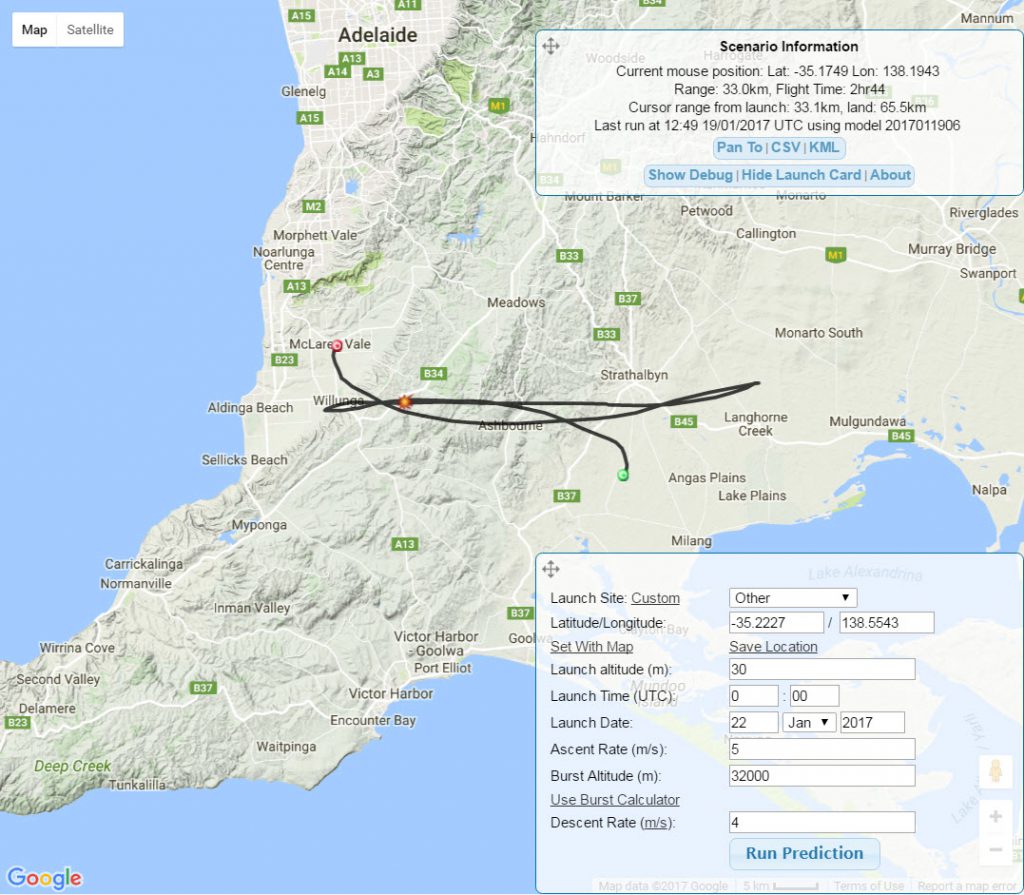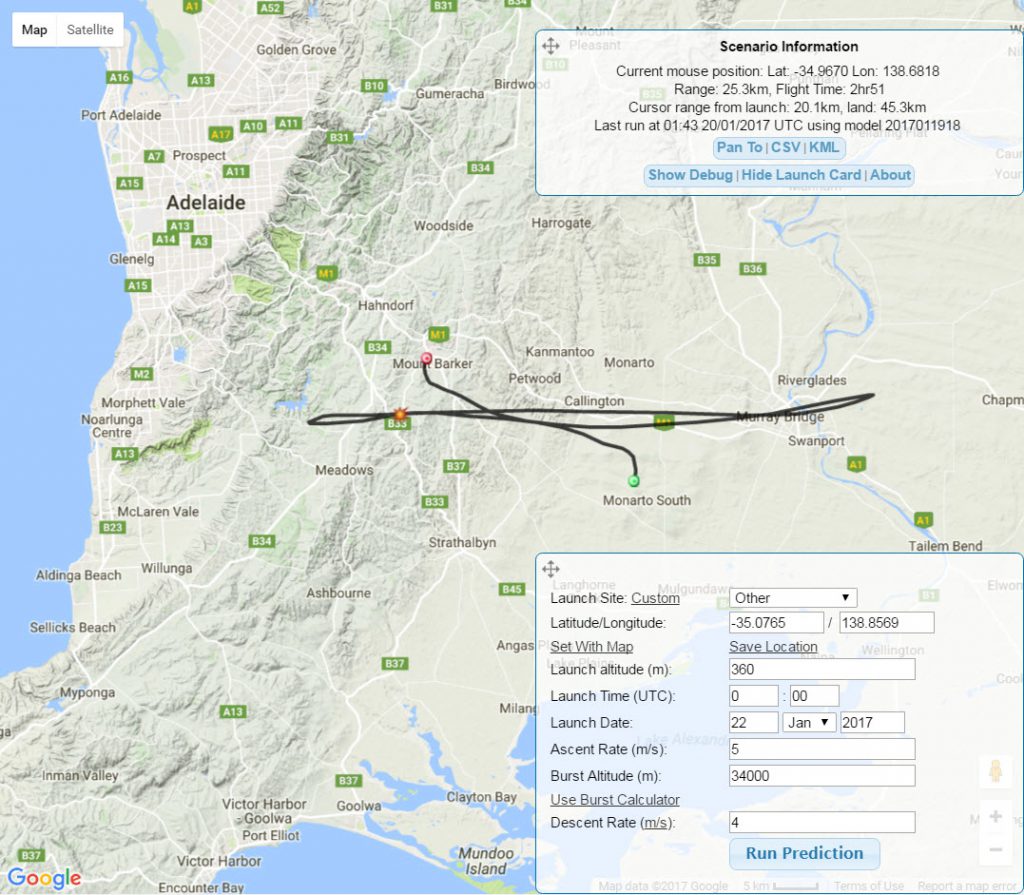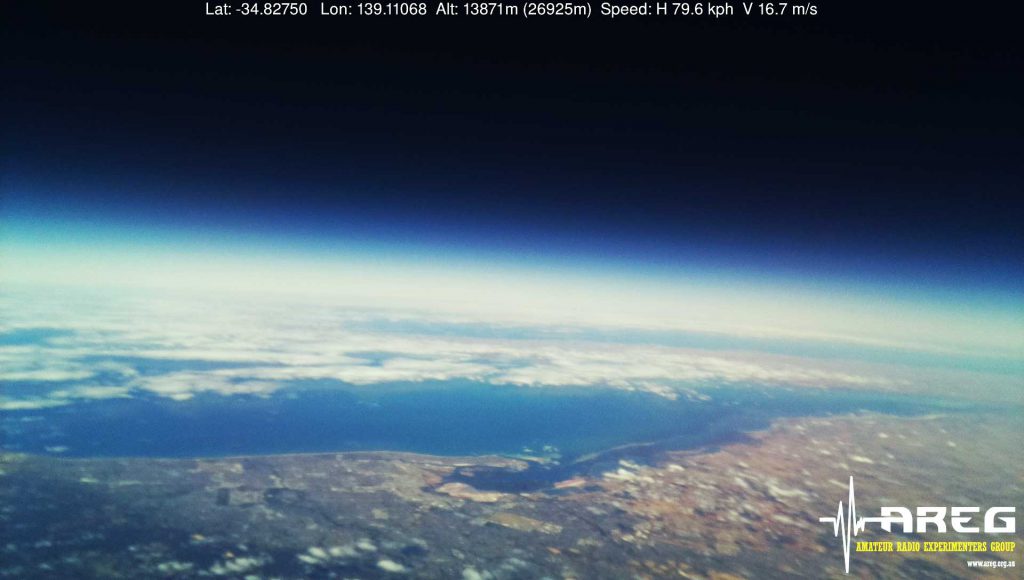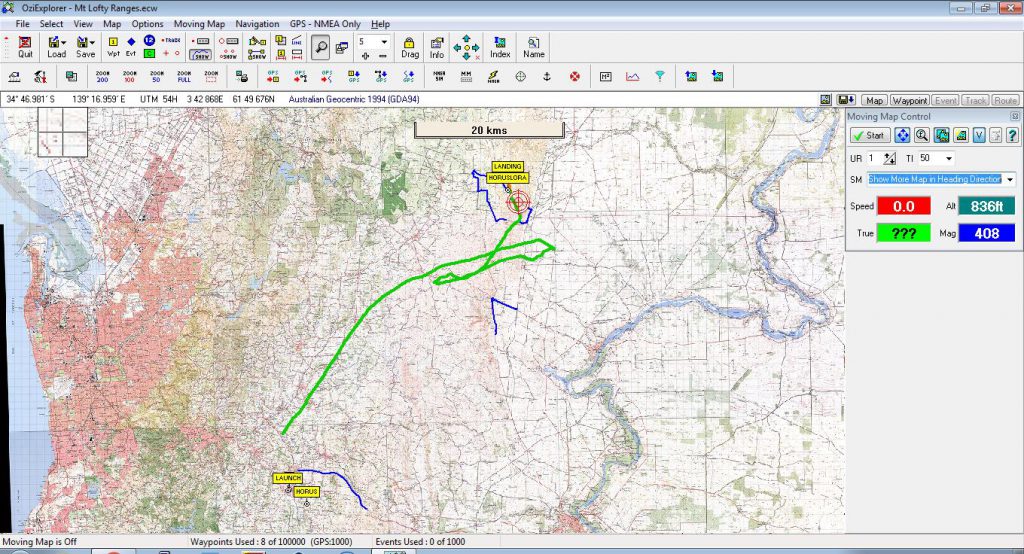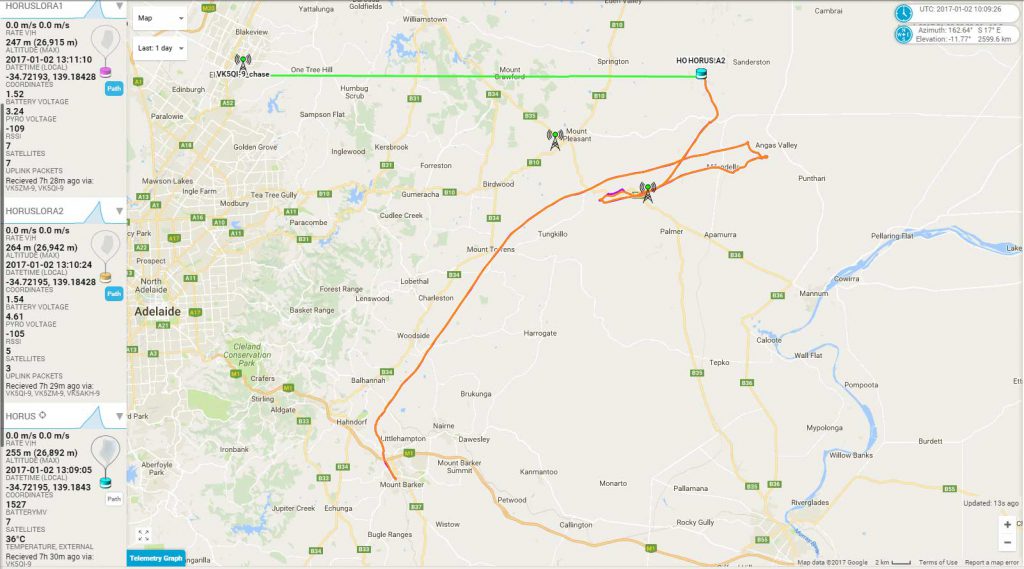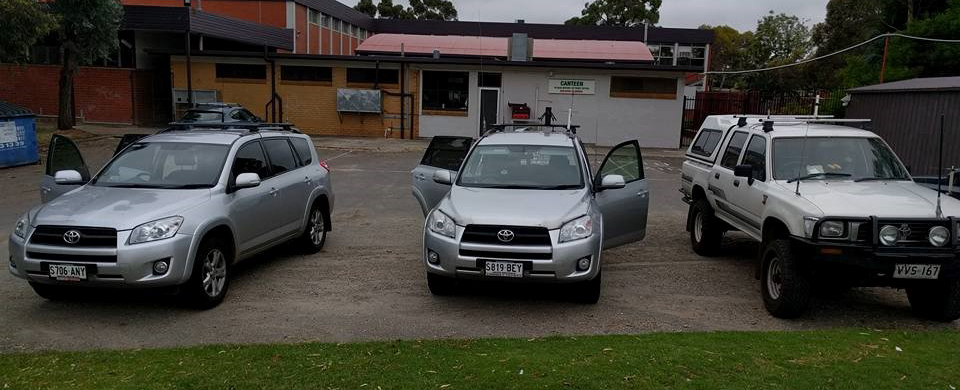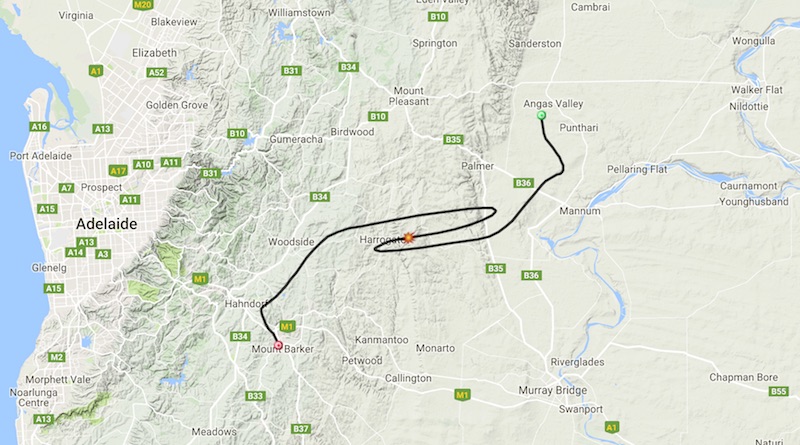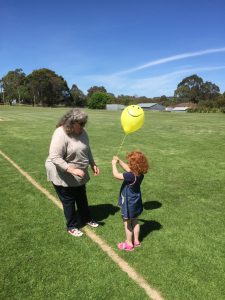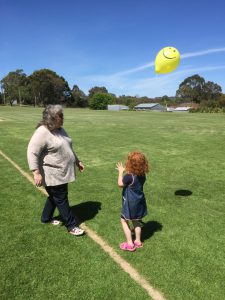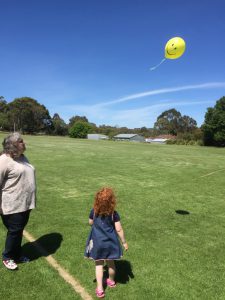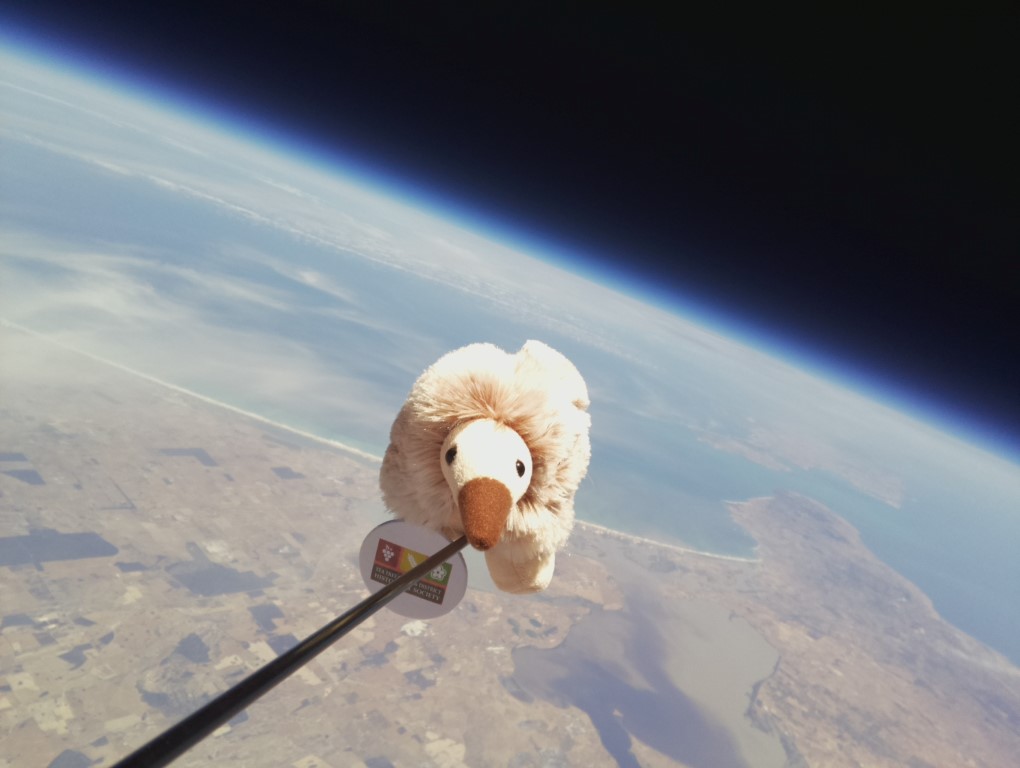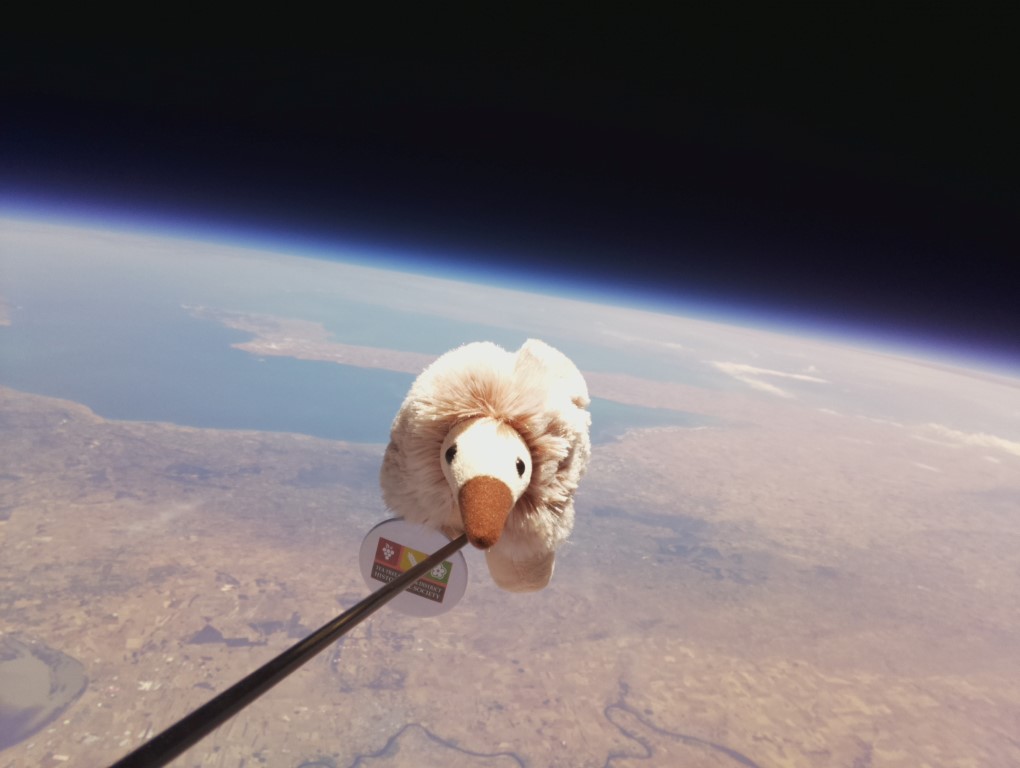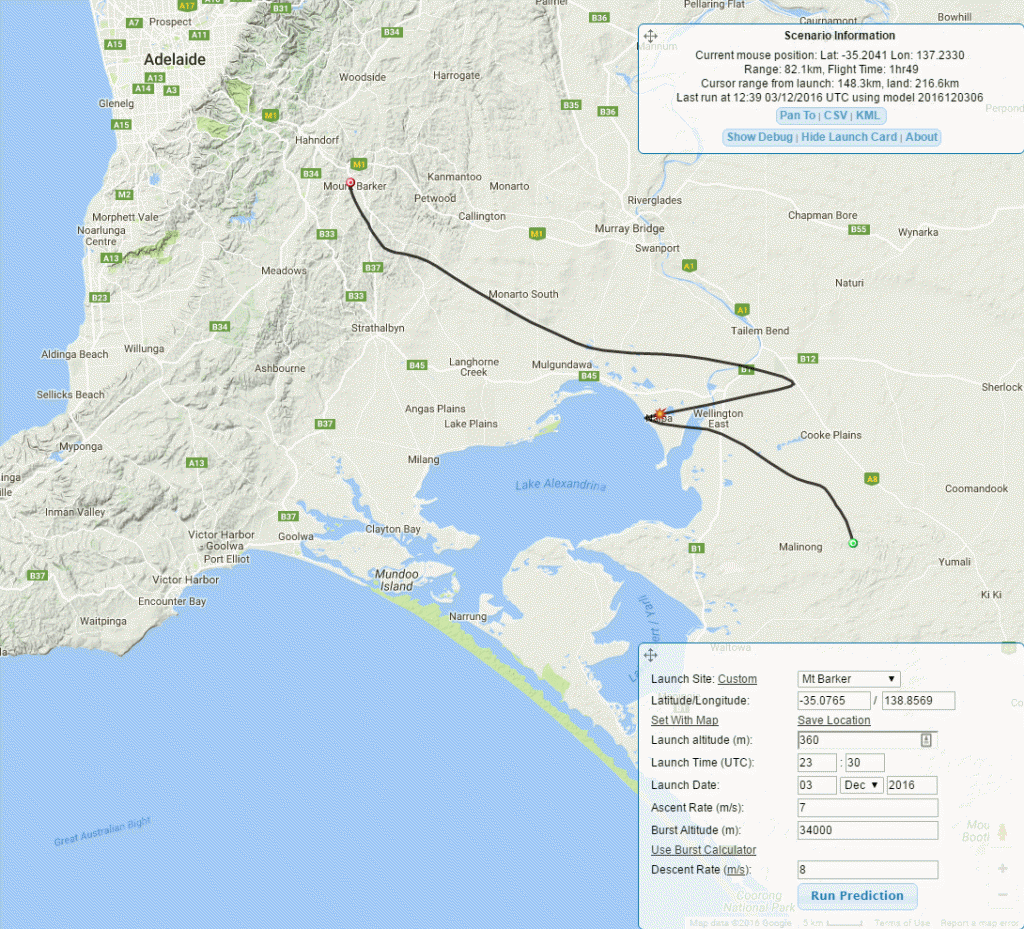Category Archives: Horus
Horus 41/42 Balloon Flights – Sunday 22nd Jan – Frequencies
The Amateur Radio Experimenters Group is pleased  to announce that it has been invited back to participate in the International Space University’s Southern Hemisphere Space Studies Program (SHSSP) for 2017.
to announce that it has been invited back to participate in the International Space University’s Southern Hemisphere Space Studies Program (SHSSP) for 2017.
This year, the club will be extremely busy with plans to simultaneously launch two balloons from two launch 
sites. This means double the number of payloads to track and double the fun for the launch and tracking teams as well!
Flight Times / Locations:
Horus 41 – McLaren Vale – 10:00am ACDT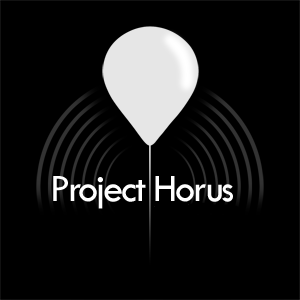
- RTTY Telemetry: 434.650MHz 100 bps
- Wenet Imagery Payload 441.2MHz 115Kbit/s
Horus 42 – Mt Barker – 10:00am ACDT
- RTTY Telemetry: 434.075MHz 100 bps
- Wenet Imagery Payload: 443.5MHz 115Kbit/s
Both balloons are intended to be launched simultaneously! Listen on the VK5RSB 70cm repeater for the launch coordination. Tracking details for RTTY payloads can be found here (click).
[wpgmza id=”12″]
Launch Site Map
Payload Information
The university project this year is using the Wenet payload designed by Mark VK5QI to accommodate 2 cameras taking alternate photographs, both facing downwards. One will be shooting in the visible light spectrum while the other will be photographing the IR spectrum. Additional telemetry is now being included also, with an Inertial Measurement Unit on board giving payload orientation data. The hope is to combine the data from both balloons into a stereoscopic representation of the terrain and vegetation below.
All of the images are being collected live and will be available via the Internet (watch this page for details closer to the day).
How to get involved?
Visitors are welcome at the launch sites on Sunday morning. AREG members are encouraged to dress in their club apparel as there will (hopefully) be lots of media around, at least at the McLaren Vale launch site at Serafino’s Winery.
You can get involved in tracking the flights from home. The more stations involved, the better! We will have our hands full with two balloons in the air so help from ground stations collecting telemetry and forwarding it to the Internet for us.
For the adventurous, you may also like to get involved in receiving the Wenet transmissions and receiving the pictures directly! All you need is a Linux based PC running Ubuntu 16.04 RX, an RTL-SDR Dongle, a preamplifier (because the RTL-SDR needs all the help it can get) and a suitable UHF 70cm antenna.
Details of the receive system are given on Mark VK5QI’s GitHub page: https://github.com/projecthorus/wenet
If you would like more information, contact the president, Matt VK5ZM@wia.org.au
More news as the launch gets closer and details are confirmed. We wont know with reasonable certainty that we are flying until ~48hrs before liftoff.
Horus 40 Flight Report: January 2nd 2017
On Monday January 2nd 2017, the Amateur Radio Experimenters Group launched a test flight of some new telemetry equipment, and trialed the updated Wenet SSDV system being developed by the group. The aim was to validate some new software ready for a dual flight being planned for January 22nd for the Southern Hemisphere Space Studies Program (SHSSP) run by the University of South Australia.
Launch Preparations
The payloads being flown this flight included:
- RTTY Telemetry (434.650 MHz 8N1 ASCII 100baud) – The usual RTTY payload as has flown in the past.
- Flight Control payload (TDMA) – we use this for telecommand to terminate the flight at the right altitude
- Secondary Test Flight Control Payload (TDMA) – In-air test of new TDMA software updates.
- Wenet Imagery Payload – 441.200 MHz 115Kbit/s Wideband FSK
- GoPro HD Hero 3 Video Payload – 25fps 1080p video – to be collected after landing
Wenet had been upgraded this flight to send back 1920×1080 frames and include on each frame some telemetry information too!
Balloon Launch Crew
On the ground, we had a large contingent of members from the Project Horus team. Matt VK5ZM lead the assembly of the balloon payload train while Mark VK5QI tended to the payloads. Grant VK5GR, Josh VK5JO, Gary VK5FGRY and Andrew VK5XFG set about filling the balloon.
Liftoff went flawlessly, which meant the chase and tracking was next.
Flight Ground Tracking Network
As in Flight 39, Peter VK5KX and crew stationed themselves on top of a hill over looking Palmer in the Adelaide Hills. From there, he was able to receive much of the data from the Wenet transmitter carrying the SSDV data.
When the balloon reached 15km altitude and was almost directly overhead, he also reported that using a telescope he was able to get a visual lock on the balloon for a time!
Bob VK5FO and Ray VK5RR operated ground control No.2 from their home near Waikerie in the Riverland. Bob reported:
“We were really trying to run several experiments on our rx capability and do a bit of a shakedown before the Dual launch. Some things worked, some things failed – but we have a much better insight into what is needed.
First off the Good.
Wenet – both of our Wenet RX set ups worked great – well, WinSDR, Pre-Amp and Laptop with software. We again used a dual-band white stick antenna – so about 8db gain on 70cm. We were able to RX images from 1,800M up to 25,000M and then from 25,000 back down to just 900M! Abovr 25,000M we did see some data, but not reliable at all.
Our 2nd Antenna – we used for experimenting with was nothing more than a mobile dual band whip – and we may as well have not bothered from this distance – 4.5db gain does not cut it.
This is very similar to what we experienced the previous flight – but this flight was much closer to us – about 90km v’s the 120-130km of the last one and as a result we had rock-solid +10db WENET signals for most of the flight – except when it was very close to the ground and again once it flew out of the antenna pattern over 25,000M
Except during the extremes, we had almost 100% decode on all images – well over 100Meg of images in the images directory!
…and then the not so good…
We had a lot of trouble even hearing the RTTY telemetry – and it was not until it was about 6,000M that we even heard it! We used our usual set up – of the IC-7100 in the car with a dual-band mobile whip to RX – and this is what we have used in the past without issue – Not so much of an Issue – except that it provides useful information WRT the Az and El of the balloon from your location – which might be needed – especially to be able to track the Payload with a directional array.
I suspect that we were had the car parked behind the shed and it was causing us to sit in the shadow of the flight until it hit the 6,000M mark. This is something easily rectified on the next flight – move the car or put the antenna on the shed roof!
As usual, the RTTY should be able to be decoded by anyone within about 100km with a fairly simple antenna, further with a little bit of gain.
So, while not everything was perfect, we were very happy with the resultant WENET Images we received.”
Flight Data
The end result of all of the ground station work was that the Wenet SSDV image payload worked a treat, Here is a slideshow of the pictures captured:
In addition, a GoPro was flown on the flight. The payload container this time suffered from some stability issues and so the images are not fantastic quality, but we did get some excellent frames out of the video at the time of balloon separation due to the tumbling. A number of selfies were taken of the other payloads and the parachute just as decent began. Check out the video here:
Flight Statistics
The flight itself was almost a text book affair. The flight track can be seen in the following animation created by Grant VK5GR from the telemetry raw data.
The vital statistics are:
[table “” not found /]
The final flight tracks can be seen here:
Chase & Telemetry Teams
The chase tracking for this flight was carried out by three teams this flight. Matt VK5ZM formed a team with Grant VK5GR, Josh VK5JO and Andrew VK5XFG, Andy VK5AKH had a team with Will Anthony VK5AHV, Darin VK5IX and his son Cam, and Mark VK5QI had a team with David VK5DGR and Gary VK5FGRY.
The chase teams in particular were using this flight to also get ready for the big dual flight planned on January 22nd.
The team would like to thank all of the following stations for their contribution to the telemetry collection effort:
VK5AKK VK5DF VK5EU VK5FTAZ VK5KJP VK5KX VK5NEX VK5NG VK5QI-1 VK5QI-9 VK5RR VK5ZEA VK5ZM VK5ZRL
Recovering Horus 40
The team had always planned on terminating the flight early as trying to recover the payloads in the Adelaide Hills, particularly the fairly remote eastern side is never easy. There were a number of tense minutes when the trigger mechanism appeared not to work, causing the balloon to fly further east than planned. Our worst nightmares looked like they were then going to materialize with a landing targeting the mountain goat country on the back of the escarpment. Fortunately, the payloads landed in a relatively accessible location, not far from an access road. A short hike up a hill and everything was found intact laid out before us awaiting collection.
Conclusion
Everyone declared Horus 40 a success, despite the issues with the delayed flight termination. Some fantastic images were obtained of Adelaide from 26km altitude, encouraging the team to continue to fly the SSDV payloads and enhance the ground station tracking systems. (More on that to follow).
Regards, The Project Horus team
Horus 40 Launch imminent – Jan 2nd 2017
Weather conditions are now looking somewhat better for a launch on Monday the 2nd of January. Liftoff is planned for 10.00am ACDT.
Ground wind conditions at Mt Barker should be light, and the current prediction (with some tweaking of launch parameters), has us landing somewhere north-east of Palmer:
Launch Details
The team will be launching from the Mt Barker High School oval. Our NOTAM’d launch time is 10AM ACDT, so we will be on-site from about 8:30-9AM. It is expected that balloon filling will take a bit longer this time, as we really need to get the balloon fill spot-on to achieve the desired flight path. Given this is an AREG test launch, visitors from the Amateur Radio community are welcome!
Payloads
There will be 5 payload boxes on this flight! (The most in a while)
- RTTY Telemetry (434.650 MHz 8N1 ASCII 100baud) – The usual RTTY payload as has flown in the past.
- Flight Control payload (TDMA) – we use this for telecommand to terminate the flight at the right altitude
- Secondary Test Flight Control Payload (TDMA) – In-air test of new TDMA software updates.
- Wenet Imagery Payload – 441.200 MHz 115Kbit/s Wideband FSK
- GoPro HD Hero 3 Video Payload – 25fps 1080p video – to be collected after landing
As usual, you’ll be able to select the flight from a drop-down list in dl-fldigi to decode the RTTY.
Tracking will be available via habhub.org 
Wenet SSDV imagery will be available via ssdv.habhub.org/VK5QI
Wenet Payload
For those club members involved in the Wenet payload data collection. you *should* be able to decode it using the software stack from last flight, however some Raspberry Pi firmware updates have slightly adjusted what ‘115200 baud’ actually means (115387 -> 115177 baud). Receivers running the old software are going to see a fairly large symbol rate error, and may experience a performance hit because of that. While the old software should work, the best preparation would be to upgrade your software.
As an upgrade, this flight will be sending ‘Full HD’ 1080p images, which should make nice desktop backgrounds! Note that this flight will be sending maybe 2x the number of images as the previous flight, due to some threading improvements made to the software.
As always, the Wenet ground-station software is available on Github at: https://github.com/projecthorus/wenet with an install guide for Ubuntu Linux here. A RTLSDR and a 70cm preamplifier are required for reception.
Launch Site Map
For those who want to see the balloon filled and lift off, here is the venue:
[wpgmza id=”10″]
Next Balloon Flight in Planning Stages
The Project Horus team through the Amateur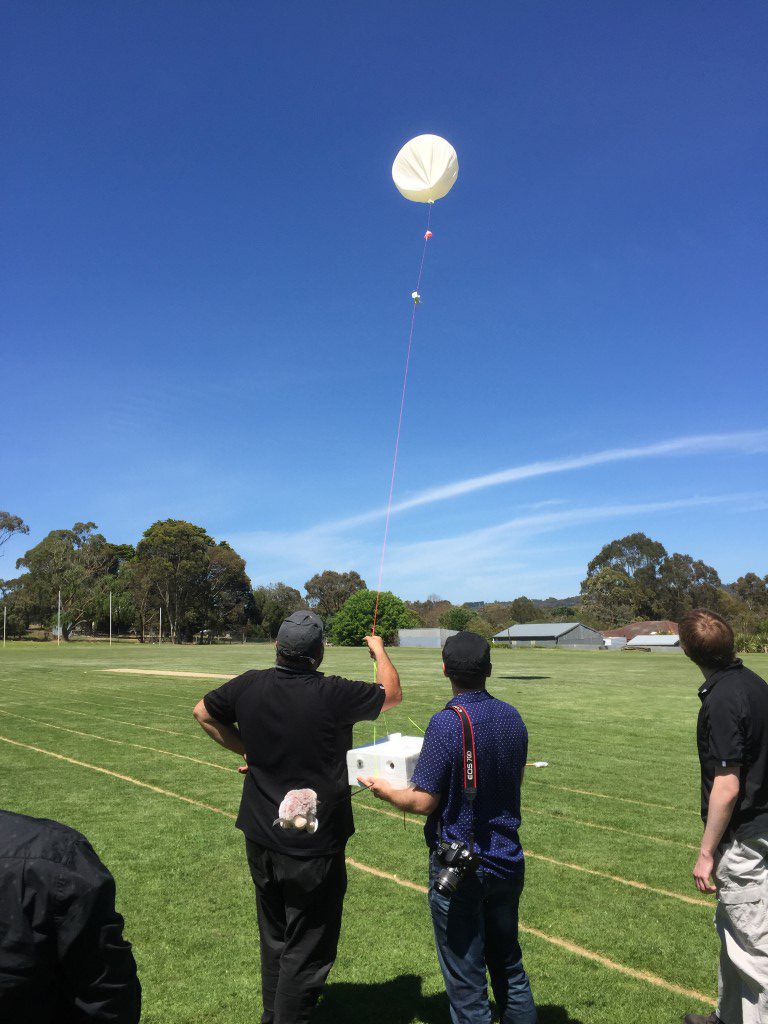 Radio Experimenter’s Group is planning another balloon flight!
Radio Experimenter’s Group is planning another balloon flight!
Well I’ve got NOTAM’s booked in for the 2nd, 4th, and 6th (Monday, Wednesday and Friday) 10AM, with the plan being to fly on Monday 2nd January. If the predictions are poor for the Monday (which is possible, given what’s coming towards SA weather wise over the next couple of days), then we may have to move to one of the other days, depending on personnel availability.
- Wenet SSDV payload (new box which I still need to build, new hardware), flying updated software. This will now have live GPS data overlaid on the image, as well as an AREG logo overlay. The images are now also full 1080p, so we’re effectively downlinking desktop backgrounds
- RTTY Telemetry (the usual, 434.650 MHz)
- Possibly a GoPro HD video camera We’ll evaluate that one closer to the date, and once I actually have a box made up for it.
Horus 39: December 3rd 2016 Flight Report
On Saturday December 3rd 2016, the Amateur Radio Experimenters Group launched the Tea Tree Gully Library mascot, Anstey the Echidna into the stratosphere as part of her next big adventure. In the past 12 months Anstey the Echidna has been to France, Italy, Ireland, Japan and New Zealand.

Flying an Echidna into near space is not without its challenges. It took a very large team of people from the Project Horus group within AREG, as well as a large number of amateur radio operators from across SE Australia to achieve this feat.
Launch Preparations
The first stage of the journey was to build the craft that would carry Anstey into the stratosphere. Mark VK5QI and Matt VK5ZM worked some long hours preparing the vehicle to make sure that not only would Anstey get a perfect view, but that those of us on the ground could also share her experience.
The cameras used included a GoPro Hero 3 and a Raspberry PiCam connected to the Wenet 115kBit/s 50mW data transmitter. This was only the second full flight of the Wenet system which has been co-developed by Mark VK5QI and David VK5DGR using an FSK modem developed by the team with help from Bill VK5DSP. (more on this shortly).
Balloon Launch Crew
On the ground, we had a large contingent of members from the Project Horus team. Matt VK5ZM lead the assembly of the balloon payload train while Mark VK5QI, Grant VK5GR, Kim VK5FJ and Gary VK5FGRY set about filling the balloon.
After the “Balloon meets tree” incident during Horus 38, we added an extra safety measure, with the release of a sounding balloon before the main launch.Grant VK5GR’s daughter, Amelia, did the honors.
Finally, the team from the Tea Tree Gully council started their Facebook live broadcast back to mission control and we prepared to send Anstey off into the sky on her epic journey.
Mission Control – Tea Tree Gully Library
Back at the library the staff had setup 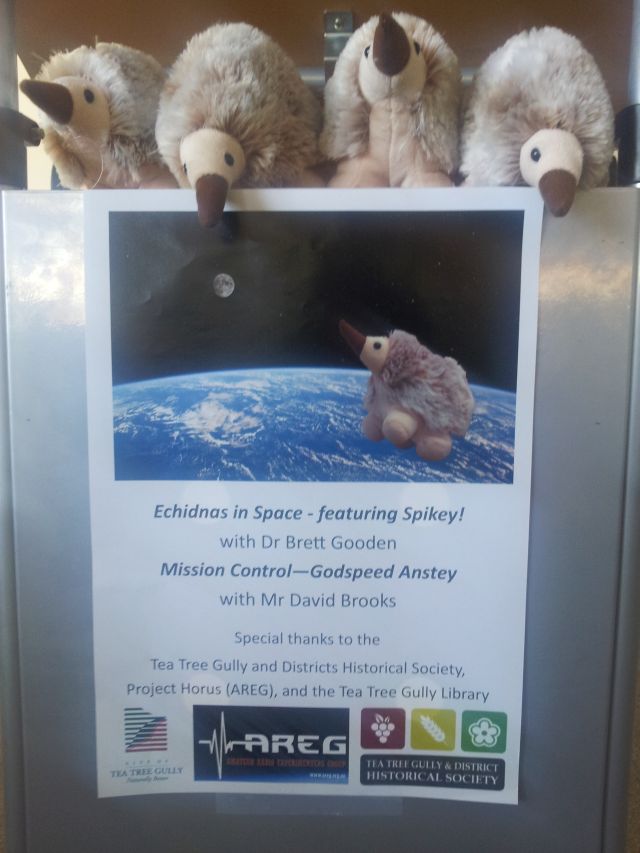 “mission control” for the morning. Ben VK5BB and Olga VK5FOLG from AREG represented our club at the library and introduced themselves to David Brooks who organised the event. Ben goes on to report:
“mission control” for the morning. Ben VK5BB and Olga VK5FOLG from AREG represented our club at the library and introduced themselves to David Brooks who organised the event. Ben goes on to report:
“David then performed the introductions, giving a little bit of history of the Tea Tree Gully area and how he believes that the local population growth was tied to events within both the USA and USSR space programs. In the back ground we were watching a number of video clips from the Launch site, looking at the equipment, Matt explaining what all the equipment in his vehicle was for, Mark explaining the tracking facilities in his car and the reporter doing his bit at launch time.
David then introduced Dr. Brent Gooden who was an expert in a number of fields, space suits, space medicine and Echidnas! He talked about how the Echidna was very well adapted physiologically wise to be able to take the rigors of space travel, all tongue in cheek but very well presented. Mean while on the wall behind the speakers, the images of Anstey were being displayed as they downloaded. Very nicely done!
Then I was invited to the rostrum to give a plug for AREG. I spent about 5 minutes talking about the history of AREG, Project Horus, that AREG was a “young” club and have a focus on radio technology and encouraging young people to look at STEM in their education which was well received.
I was well thanked by David and he publicly acknowledged that without AREG and Project Horus, this event would not have happened.”
Flight Ground Tracking Network
The next major component of the event was the flight ground tracking network. To retrieve the transmitted images from the balloon, we had positioned several stations around the state equipped with RTL-SDR dongles, pre-amps and the receiving software designed to collect the Wenet 115kBit/s telemetry stream. Station No.1 was Peter VK5KX and his partner Wendy, who camped on top of a hill overlooking Palmer on the eastern face of the Adelaide Hills.
Peter reports “Wendy & I drove up to Palmer Saturday morning. We had to do some extra km’s due to chain of ponds road being closed, however we got there and rushed the setup completing everything in a nick of time. We were getting SSDV images before we had a lock on the balloon RTTY payload.
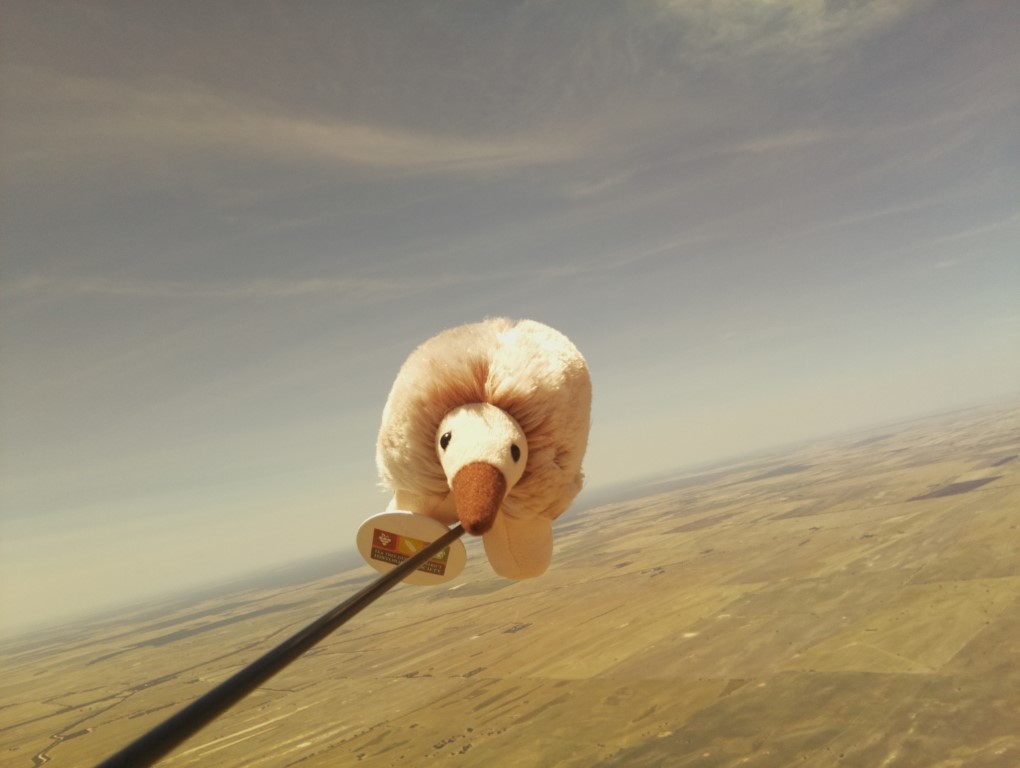 Pointing the 5 element 70cm beam at a point in space to Rx the SSDV images was no easy task. I tried using a compass app on the phone, even a Theodolite app, but they were both giving erroneous readings, so I reverted back to a handheld magnetic compass. I did mange to get used to it and made a few notes as to where to point the beam and at what angle of elevation. Some perfect images were decoded and uploaded.
Pointing the 5 element 70cm beam at a point in space to Rx the SSDV images was no easy task. I tried using a compass app on the phone, even a Theodolite app, but they were both giving erroneous readings, so I reverted back to a handheld magnetic compass. I did mange to get used to it and made a few notes as to where to point the beam and at what angle of elevation. Some perfect images were decoded and uploaded.
After the balloon burst, we manage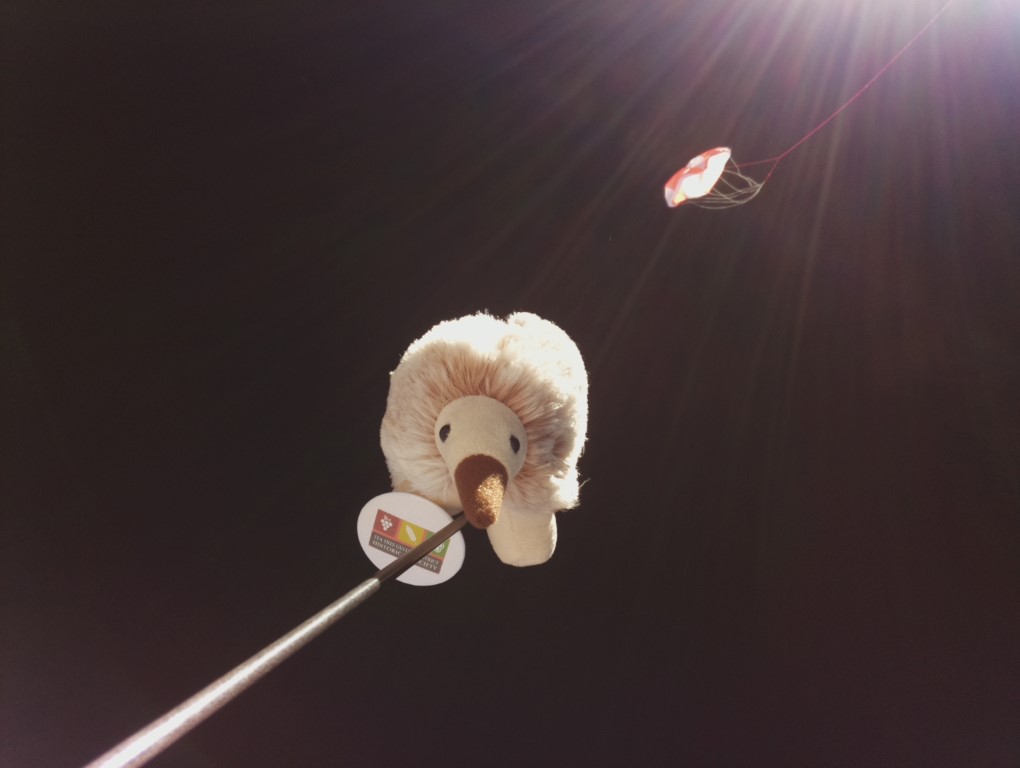 d to track it for some time before starting to have some issues decoding the RTTY. I could see the data clearly but the fl-digi window stayed red, only occasionally going green. To be investigated later. We went on to camp on the hill that night in preparation for Horus 40 on Sunday morning.
d to track it for some time before starting to have some issues decoding the RTTY. I could see the data clearly but the fl-digi window stayed red, only occasionally going green. To be investigated later. We went on to camp on the hill that night in preparation for Horus 40 on Sunday morning.
When Sunday arrived, the weather appeared with a vengeance. The winds
were so fierce that they nearly blew us away. It did managed to blow some seats and gear down the hill. Unfortunately in it’s path was the beam antenna on it’s tripod. I now need to do some maintenance on the beam. I notified the Sunday launch crew that we were pulling the plug and then the fun began as we tried to expediently get all the gear in the bus somewhere. Then the rain started too, as I ventured 2/3 the way down the hill to retrieve a red plastic box, the trip back to the bus against the wind & uphill wasn’t pleasant…..”
Bob VK5FO and Ray VK5RR operated ground control No.2 from their home near Waikerie in the Riverland. Bob reported:
“at the last minute before the Launch, we were able to borrow an RTL-SDR and Pre-Amp in order to set up an additional station to RX the SSDV pictures from the Balloon. The RX station was set up in the Riverland, near Waikerie and was reporting Telemetry and Image data as VK5RR.
Given that the site was about 100km+ away from the flight path, it was actually an unknown if it would even RX any data. We monitored the flight data and once the Balloon hit around 6,000M we started to RX some telemetry. It was noted that once the signal got to around 6 or 7db above the noise floor it was getting consistent decodes.
Now, the Antenna used was not ideal – it is a typical “white stick 2/70 Dual band antenna, around 25M of RG-213 before the Pre-Amp. Once we were getting good decodes the RX site was left unattended for the rest of the flight. We contributed to the image data on SSDV.habhub.org and noticed that at around the 27,000m mark we lost RX of the image signal. This was probably a null in the Antenna – given that this was probably around the 25 Degrees elevation from the RX location.
After the Balloon burst, we again started to RX Image data, and this time it was right down to approx 2,000M (at over 140km away).
On checking the recorded images, we had partial data on several, and nearly 100% of others. A total of 127 Images (complete and partial) were received, and a total of 253 images of the flight were recorded and uploaded. The RX site provided image data for around 1/2 of the images of this flight.”
We also had Kim VK5FJ receiving the balloon from Mt Barker as well as the two mobile recovery vehicles with VK5QI and VK5ZM, all who contributed some data to the successful images relayed back to Mission Control live from the balloon.
The following animation is compiled from the still images collected from the balloon SSDV telemetry system.
More details about the Wenet system designed by the Horus team and the SSDV platform provided by UKHAS and Phil Heron can be found elsewhere on the AREG site.
Flight Statistics
The flight itself was almost a text book affair. The flight track can be seen in the following animation created by Grant VK5GR from the telemetry raw data.
The vital statistics are:
[table “” not found /]The team would like to thank all of the following stations for their contribution to the telemetry collection effort:
VK5APR, VK5EU, VK5FTAZ, VK5KJP, VK5KX, VK5NEX, VK5PJ, VK5QI, VK5RR, VK5ZEA, VK5ZM
Recovering Anstey – in a field of Triticale
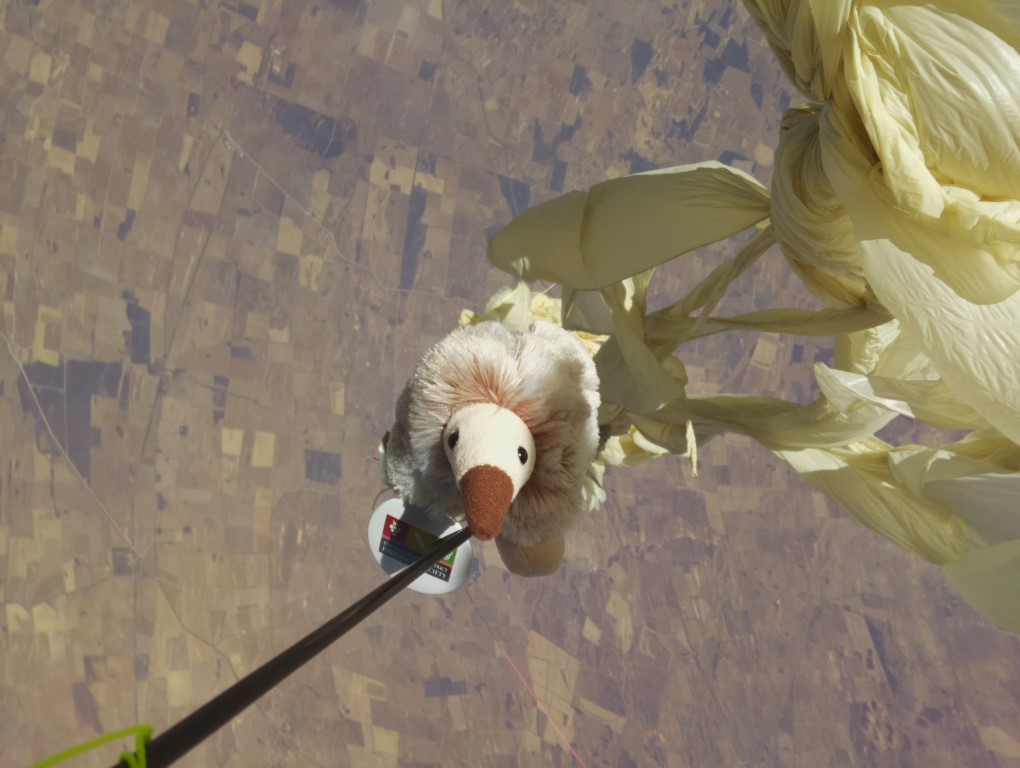 The final act was for the balloon to burst and for Anstey to return to earth to tell her tale. The mobile tracking crews, based on the available predictions, had headed for Lameroo in the Murray Mallee about 250km east of Adelaide. Once the balloon burst however, we discovered that it was falling faster than predicted.
The final act was for the balloon to burst and for Anstey to return to earth to tell her tale. The mobile tracking crews, based on the available predictions, had headed for Lameroo in the Murray Mallee about 250km east of Adelaide. Once the balloon burst however, we discovered that it was falling faster than predicted.
We determined that again the burst hadn’t been a clean one (confirmed with one of the SSDV images we collected) and along with the payloads, a large chunk of the balloon was coming back still attached! The drag of the parachute slowed the descent, but not as slow as originally planned, with the payloads eventually returning to earth at ~9m/s. This caused something of a scramble among the tracking teams as the landing suddenly looked to be about 30km short of where we expected. Fortunately, we weren’t that far away when it touched down, and a good fix from the beacons was obtained before the landing.
After about 20 minutes, we had located the land owners, who were curious to see what we had landed on their property. They were very helpful and friendly farmers who lead us to the landing site in our vehicles. We should have been able to drive right to the payload, except at the critical moment, the telemetry computer crashed in the VK5ZM chase car. So, out with the yagi and direction finding gear to find Anstey the old fashioned way.
After a further 15 minutes, and a hike across a 1m high crop paddock, Anstey was found safe and well.
Conclusion
Everyone declared Horus 39 a success, and looking at the comments and feedback received via social media, it would appear it was very well received by the amateur radio community across Australia as well. We are looking forward to the next time we can fly and hope you will come on the journey too! 73 de Project Horus, Adelaide!
HORUS 40 Balloon Flight: Sunday 4th Dec – CANCELLED
 The flight planned for today had to be cancelled at the last minute due to the weather conditions at the launch site. Heavy rain and high winds just as we were to start filling the balloon forced us to call a halt to the proceedings.
The flight planned for today had to be cancelled at the last minute due to the weather conditions at the launch site. Heavy rain and high winds just as we were to start filling the balloon forced us to call a halt to the proceedings.
The planned flight will now be rescheduled for the first few weeks back at school in the new year (first week of February is being considered)..
It is a very busy weekend for the Project Horus team within the Amateur Radio Experimenters Group. Yesterday (Saturday) we flew a payload for Tea Tree Gully Council Library. Today (Sunday) we are flying a STEM (Science, Technology, Engineering & Mathematics) payload through LaunchBox for a local Adelaide high school.
The predicted flight track for Horus 40 is below.
The parameters being considered for this flight will make it a fast one, as we are aiming to prevent it landing in the inaccessible territory at the western end of Ngarkat Conservation Park, plus we have some less than favorable surface launch conditions to deal with in the morning according to the Bureau of Meteorology.
Horus 40 Flight Details
Liftoff is planned for 10AM ACDT from Mt Barker High School. The payloads will be:
- Standard RTTY Telemetry: 434.650 MHz, 100 baud ASCII-7N1
- Wenet Imagery Payload: 441.200 MHz
- LaunchBox payload
- Flight Path Management and Control Payload
Tracking will be available via habhub.org 
SSDV imagery will be available via ssdv.habhub.org/VK5QI
How can you get involved?
Amateurs across SE Australia can contribute to the flight through RTTY telemetry data collection and forwarding to the Internet. Multiple members of AREG are also involved collecting the SSDV imagery data from the 115kbit/s high speed downlink. Follow the links from HabHub or on the AREG website for more details.


